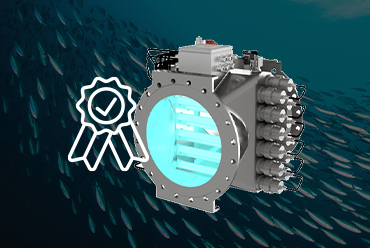
November 2025

November 2011
TEST PREMISES
DESMI Ocean Guard was the first to conduct ballast water treatment tests with a UV based system in fresh water and during this process they met some unexpected challenges. Their findings offer new information to the ship owners that will soon have to ensure that their vessels are in accordance with IMO regulations.
Ballast Water Treatment is a new topic in the marine world and not much experience has been gathered yet. That became very clear to DESMI Ocean Guard who chose to test their ballast water treatment system not only in saline but also in fresh water. IMO Resolution 174(58) only requires tests in two of three water types, viz.
• Fresh water with salinity lower than 3 ‰,
• Brackish water with salinity between 3-32 ‰
• High-salinity water with salinity above 32 ‰
So far only the last two types have been tested by other companies offering UV-based concepts.
DESMI Ocean Guard decided to test the system in fresh water and brackish water as these water qualities seemed to be more challenging. Additional requirements to silt (non-organic solids) in the test water are outlined in the IMO-Resolution, and this was taken into consideration knowing that ship owners have a natural concern about filters in their ballast water systems. Also, testing the system in fresh water is very relevant since quite a few larger harbours are fresh water harbours either the entire year round like Antwerp, or in some periods of the year like Hamburg and Bremerhaven. The same applies to several Asian harbours that are of strategic importance to A.P. Møller-Maersk. Therefore, a water treatment system that has been approved by IMO, but only tested in salt or brackish water, may unexpectedly deliver unsatisfactory test results.
DESMI Ocean Guard A/S was established by A.P. Moller Maersk A/S, DESMI A/S and Skjølstrup & Grønborg ApS following a successful innovation project carried out by Maersk Maritime Technology, DESMI and Skjølstrup & Grønborg. It was decided to perform the required land-based tests at the accredited test institute in Hundested (Denmark) which is owned and operated by DHI (Danish Hydraulic Institute) whose expertise and assistance were greatly appreciated during the process.
TEST PROCEDURE
The test water is treated in three steps
• filtration
• UV radiation
• and ozone generated in-situ by the UV-system
The DESMI Ocean Guard system is very energy-efficient and compact. Maximum observed power consumption of the entire system is 11 kWh/100 m3. This makes it very attractive to ship owners who are very conscious about lack of space and power availability onboard their vessels.
The first tests were carried out in brackish water and the results were compatible with IMO regulations right away. The fresh water tests, however, presented an unexpected outcome. They showed that too many large organisms (over 50 microns) could get through the system. It made specialists wonder, because the filter mesh is 40 microns which was enough to effectively remove organisms larger than 50 microns in brackish water.
Since no similar tests have been done before, specialists from DESMI Ocean Guard and DHI had to find the answers themselves. It turned out that some fresh water species are much softer than the ones living in waters of higher salinity and could easier squeeze through the tight filters.
The IMO regulations are very strict when it comes to larger organisms. Three water samples are taken and the average amount of organisms over 50 microns has to be less than 10 organisms per cubic metre. Whereas when it comes to smaller organisms, it should be less than 10 organisms per millilitre.
DESMI Ocean Guard’s specialists realized that the filter, which in the beginning seemed to be the simplest and least important part of the system, had a huge impact on the success of the test results when it comes to the larger organisms. Right now DESMI Ocean Guard has a patent pending related to the novel way of using the filter. By using the unique DESMI Ocean Guard method, more than 90% of the tests for larger organisms showed 0 viable organisms.
Right now the system is going through the IMO shipboard test onboard the container vessel of Thurø Maersk. The first two out of three required tests have already been successfully completed. The salinity of the water tested aboard Thurø Maersk is high (34 ‰), meaning that the DESMI Ocean Guard Ballast Water Treatment System has right now been successfully tested in all three salinities. At present DESMI Ocean Guard awaits the required 6 months test interval to pass before the final test can be finalized by March 2012. The system will be type-approved shortly after this.



November 2025

October 2025

October 2025

September 2025